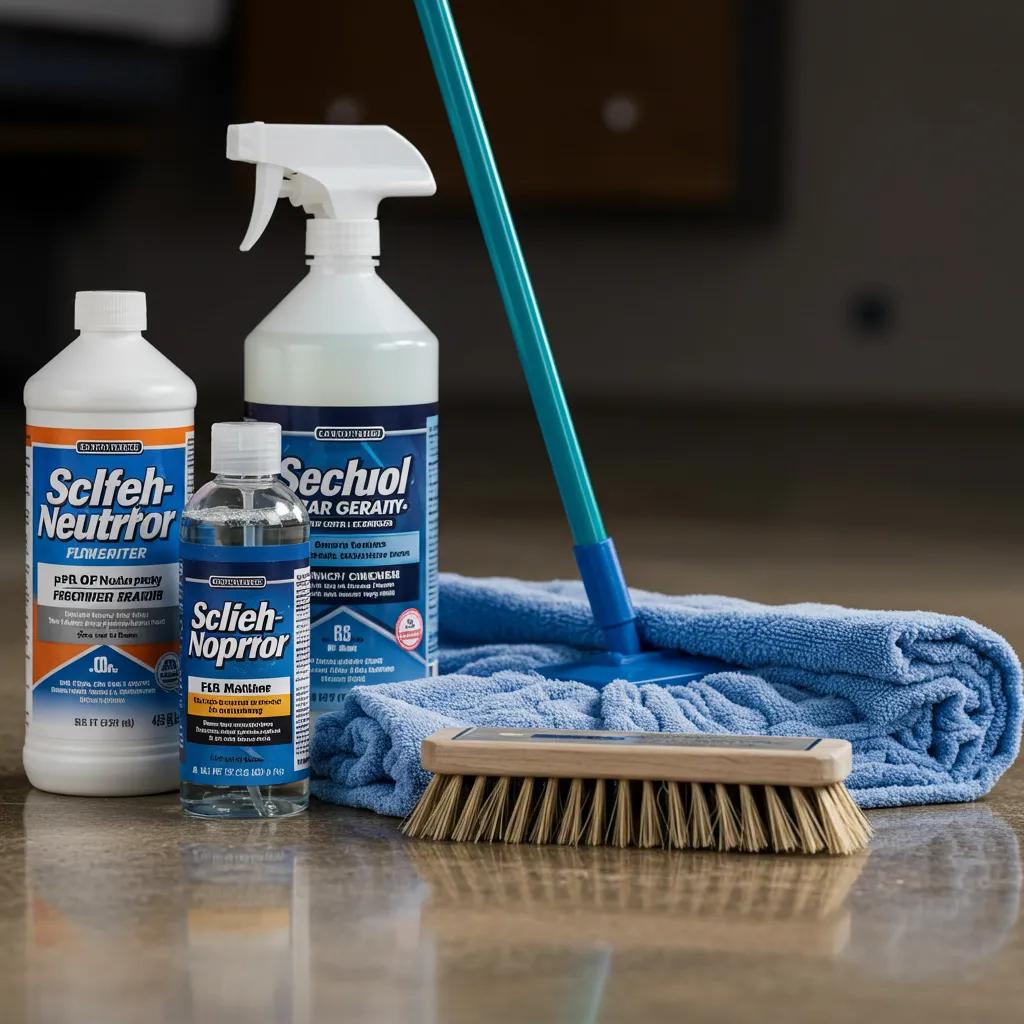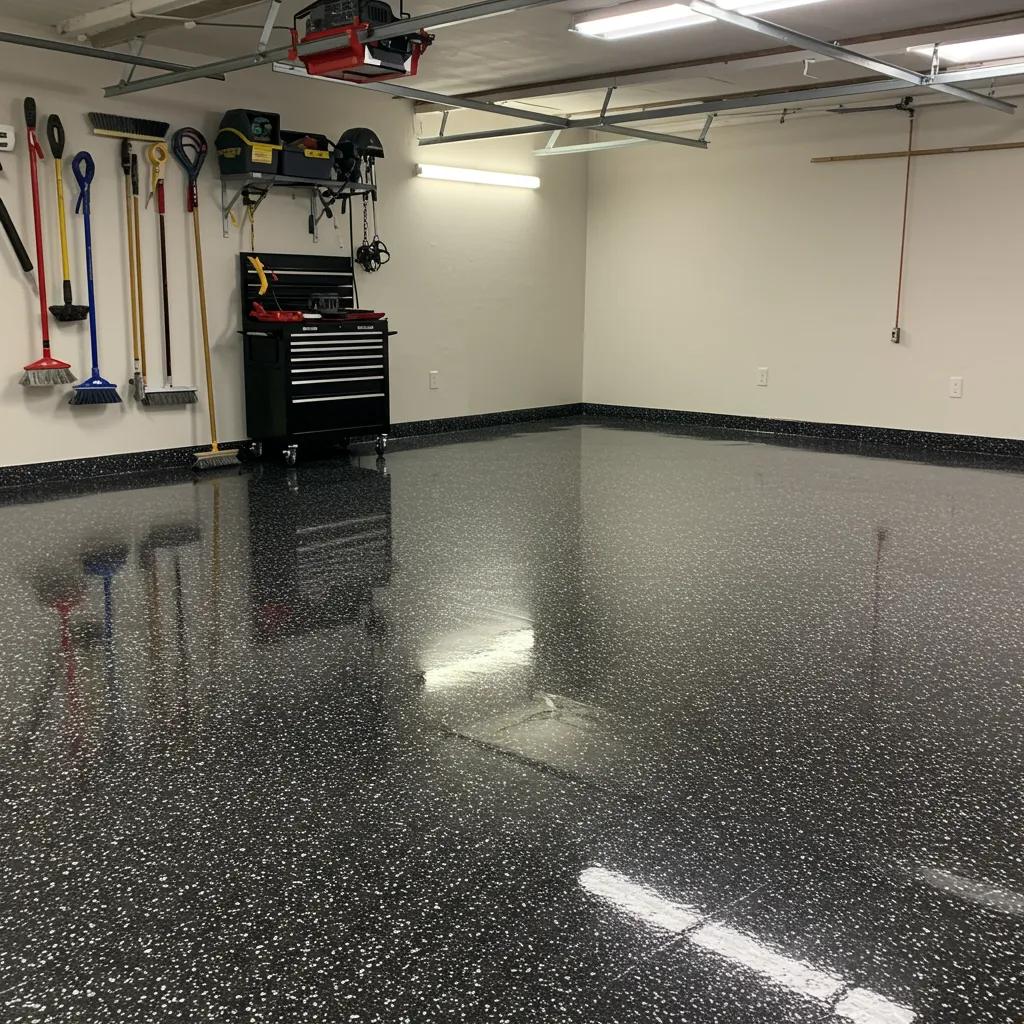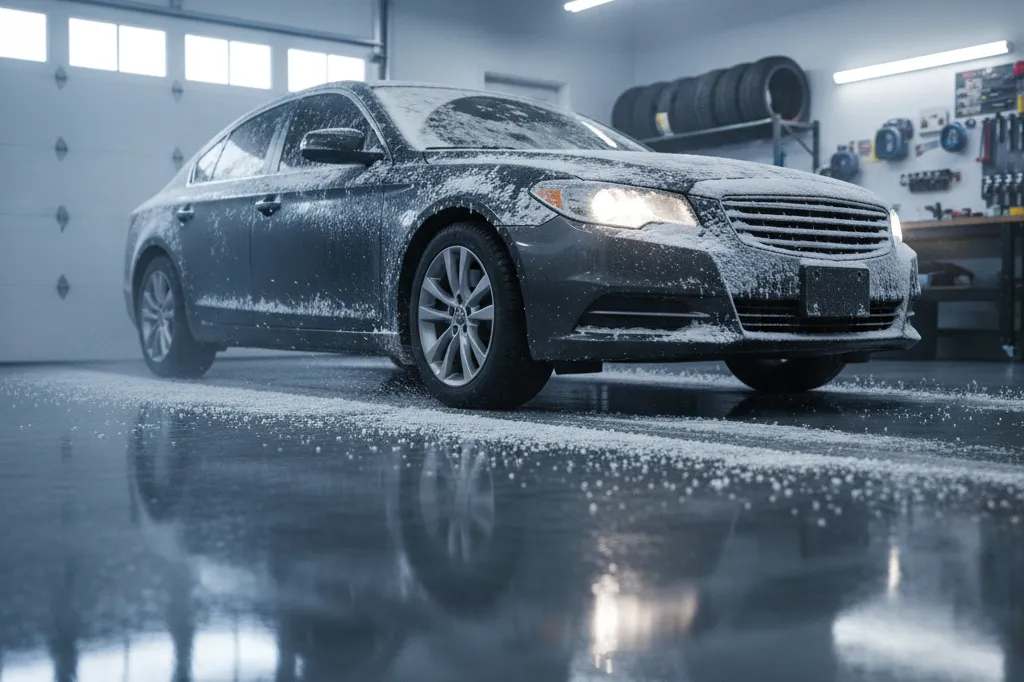Epoxy garage floor coatings are a multi-layer protective system applied over concrete that combines primer, epoxy resin, decorative flakes (if used), and a durable topcoat to deliver chemical resistance, abrasion protection, and a finished appearance. In Chicago’s climate—where road salt, snow melt, and freeze-thaw cycles are common—regular maintenance preserves those protective layers and prevents tracked contaminants from degrading adhesion or finish. This guide teaches Chicago homeowners and light-commercial operators how to clean, protect, troubleshoot, and know when to repair or recoat epoxy and related polyurea/polyaspartic coatings for long-lasting results. You will learn a practical cleaning routine tailored to local seasons, step-by-step stain removal for oil, rust, and tire marks, winter and spring preventative actions, and clear decision points for DIY patching versus professional service. The sections that follow cover cleaning methods and safe products, stain remediation workflows with emergency actions, climate-focused prevention strategies including mat and sealer use, and recoating triggers with repair options—helping you extend the life and appearance of your garage floor coatings.
What Is the Best Way to Clean Epoxy Garage Floors in Chicago?
Cleaning an epoxy garage floor begins with removing loose debris, then performing a pH-neutral wet clean that preserves the resin topcoat and sealer while restoring slip resistance and appearance. Regular cleaning works because it prevents abrasive grit and corrosive salts from abrading the protective floor surface and migrating into joints or edges, which protects adhesion and limits micro-abrasion. The immediate benefit is sustained gloss and resistance to stains so the coating lasts longer and resists costly repairs. Implement this approach as a routine: daily or weekly dry debris removal followed by scheduled wet cleaning and seasonal deep cleans after winter. The next subsections explain which cleaners and tools are safe for epoxy and how often to perform each maintenance task.
Which Cleaning Products and Tools Are Safe for Epoxy Garage Floors?

Choosing the right products and tools prevents chemical or mechanical damage to the epoxy resin, primer layer, and surface prep. Start with a pH-neutral cleaner diluted per label directions, applied with warm water and agitated with a microfiber mop or soft-bristle broom; avoid acidic or strongly alkaline detergents that can etch or dull the finish. Soft tools—microfiber mop, soft-bristle push broom, squeegee, and a non-metallic scraper—remove soil without scratching the decorative flakes or topcoat. Use a wet vacuum or squeegee to remove rinse water, and test any stronger degreaser in an inconspicuous area before wider use. Choosing these epoxy-safe cleaners and tools protects the coating components and prepares surfaces correctly for occasional deeper cleaning or spot treatment.
Cleaning products comparison for common use cases:
| Cleaner Type | Recommended Dilution/Use | Best Use Case |
|---|---|---|
| pH-neutral floor cleaner | Follow label; generally 1–2 oz per gallon warm water | Routine weekly or monthly wet clean |
| Epoxy-safe degreaser | Spot-test first; use sparingly and rinse thoroughly | Heavy oil/grease spots |
| Mild dish soap solution | 1–2 tsp per gallon warm water | Light soiling, safe alternative for frequent mopping |
This table helps match cleaner strength to the job while reducing risk to the coating; always rinse and dry after use to avoid residue buildup.
How Often Should You Clean Your Epoxy Garage Floor for Optimal Longevity?
A maintenance cadence keyed to traffic, weather, and use patterns keeps epoxy coatings performing well and extends service life. For light residential garages, sweep daily or every few days and wet-clean weekly; for moderate to heavy use or commercial settings, sweep daily and deep-clean every 1–2 weeks, with monthly inspections for tracked salt or chemical spills. Seasonal actions matter in Chicago: remove salt residues promptly during winter, perform a spring deep clean to strip tracked de-icing materials, and inspect joints and edges after freeze-thaw cycles. Adjust frequency upward for visible spills, vehicle leaks, or tracked grit to prevent abrasion and staining. This schedule balances routine care with periodic deep interventions so coatings maintain adhesion, appearance, and protective function.
Routine cleaning guidance summary:
- Daily: Sweep or vacuum to remove grit and debris.
- Weekly: Wet-mop with a pH-neutral cleaner and rinse thoroughly.
- Monthly/Seasonal: Deep clean and inspect for stains, chips, or edge lift.
Regular cadence preserves the topcoat and reduces the need for repairs, and the next major section details stain-specific removal techniques.
How Can You Remove Common Stains from Epoxy Garage Floor Coatings?

Effective stain removal starts by identifying the stain type and choosing an epoxy-safe method that removes contaminants without harming resin or topcoat. Oil and grease respond to absorbents followed by an epoxy-safe degreaser and agitation; rust requires a chelating approach or mild rust remover tested in a small area first; tire marks often need a solvent-based cleaner or mechanical scraping with a plastic scraper. Safety and containment matter for chemical spills—ventilate, use PPE, and neutralize corrosive agents when possible to limit damage to the coating and underlying concrete. The following subsections provide step-by-step methods per stain type and emergency actions for hot-tire pickup or hazardous spills.
What Are the Most Effective Methods to Remove Oil, Rust, and Tire Marks?
Match the stain type to method and tool for predictable outcomes while protecting the epoxy layers. For oil: blot fresh leaks with absorbent powder, then apply an epoxy-safe degreaser, agitate with a soft brush, and rinse; repeat if needed and allow to dry. For rust: apply a chelating agent or mild rust remover on a test patch, follow dwell time, scrub gently, and neutralize before rinsing to avoid etching. For tire marks: cool the tire-contact area if hot, use a plastic scraper to lift residues, and clean with a solvent-safe cleaner according to product guidance; repeated prevention is more effective than repeated removal. These targeted steps minimize mechanical and chemical risks to the coating and produce better cosmetic results.
Stain removal quick-reference (for on-the-spot actions):
- Oil and grease: absorb, degrease, agitate, rinse.
- Rust: test chelator, apply, scrub gently, rinse.
- Tire marks: cool, scrape with plastic tool, solvent clean.
Following these prioritized methods improves the chance of full stain removal without damaging epoxy, and the next subsection covers hazardous spills and bonded hot-tire marks that may require faster containment or professional help.
How Do You Handle Chemical Spills and Hot Tire Pickup on Epoxy Floors?
Immediate containment and safe neutralization prevent chemical aggression and long-term bond failures in the topcoat or primer layers. For chemical spills, isolate the area, ventilate, don PPE, and use absorbents to limit spread; neutralize acids or bases per safety guidance, then clean with epoxy-safe products and rinse. For hot-tire pickup, allow surfaces to cool, then use a plastic scraper and cleaning solvent formulated safe for epoxy; in severe bonding cases where the topcoat has pulled or blistered, avoid aggressive abrasives and seek professional assessment. When these issues extend beyond small spots or if the coating has started to peel, contact a nearby epoxy specialist for on-site evaluation. Knowing when to call for help prevents deeper substrate damage and keeps repairs manageable. Acting quickly and choosing the right removal approach reduces permanent damage and limits repair scope.
How Does Chicago’s Climate Affect Epoxy Garage Floor Maintenance?

Chicago’s seasonal extremes influence both the chemical and mechanical stress on epoxy coatings, as tracked road salt accelerates chemical attack while freeze-thaw cycles stress edges and joints. Salt and de-icing slurries contain chlorides that can be abrasive and retain moisture, which increases the chance of edge lifting or micro-delamination if left in place; snow and ice tracked indoors compound this effect. Seasonal inspection points include joints, garage door perimeters, and transition areas to uncoated concrete, since moisture migration and freeze-thaw stresses often show first at edges. The next subsections explain practical preventative measures for salt and freeze-thaw and how mats and sealers can mitigate these local risks.
What Preventative Measures Protect Epoxy Floors from Salt, Snow, and Freeze-Thaw Cycles?
Adopt a proactive, season-specific routine to keep corrosive salts and freeze-related moisture from undermining the coating’s adhesion and surface integrity. After snowy or icy days, remove tracked salt promptly with a dry sweep then a pH-neutral wash to eliminate residues; inspect edges and joints for moisture intrusion and re-seal or patch small gaps before they widen. Use doormats to trap grit at entry points and deploy absorbent runners during high-salt periods to limit migration. Timely detection and simple preventive actions—cleaning salted areas within 24–72 hours and maintaining seals—lower the chance of costly edge delamination and preserve the coating’s protective layers.
Recommended seasonal checklist to reduce climate impact:
- Remove tracked salt within 24–72 hours.
- Use entry mats to capture grit and slurry.
- Inspect and patch edges after thaw cycles.
Taking these preventative measures reduces the risk of freeze-thaw damage and prepares the floor for occasional recoating when needed.
How Can Floor Mats and Sealers Extend Epoxy Floor Durability in Chicago Weather?
Floor mats and supplemental sealers act as sacrificial layers and physical barriers, reducing direct exposure of the topcoat to abrasive grit, salt, and moisture. Choose absorbent, grit-capturing mats at doorways and under vehicle tires when snow or road salt is expected, and position runners to protect high-traffic pathways; periodic cleaning of mats prevents them from becoming secondary contaminant sources. In high-exposure zones, an additional UV- and chemical-resistant topcoat or sealer can improve slip resistance and chemical resistance, but reapplication intervals depend on traffic and exposure. Maintaining mats and timely reapplication of protective topcoats preserve the epoxy system by limiting direct assaults on the resin and decorative layers.
Mat and sealer maintenance tips:
- Clean mats weekly during winter months.
- Inspect sealer wear annually or after severe seasons.
- Replace mats that retain salts or oils that cannot be fully removed.
These protective strategies reduce wear and extend the coating’s serviceable life, leading into criteria for repair and recoating decisions.
When Should You Repair or Recoat Your Epoxy Garage Floor for Long-Lasting Results?

Deciding to repair or recoat is based on visible wear, functional decline, and scope of damage; timely small repairs avoid larger, costlier interventions later. Surface scratches, isolated chips, and minor abrasions are typically repairable with patch kits or spot sanding and touch-up, while widespread delamination, bubbling, or persistent staining that withstands remediation signals the need for professional evaluation and likely partial or full recoating. Recoating restores chemical resistance, UV/topcoat protection, and aesthetics, and understanding the expected lifespan of epoxy coatings helps homeowners plan timely maintenance and avoid premature wear. The following subsections give a repair decision checklist and explain how recoating improves longevity and appearance.
What Are the Signs That Indicate Minor Repairs or Professional Maintenance Is Needed?
Assess the floor using a diagnostic checklist that distinguishes cosmetic wear from structural adhesion failures so you can choose the right remedy. Minor signs—surface scratches, small chips, or localized stains—are often suitable for DIY patching using epoxy scratch/chip repair kits, with careful cleaning and light abrasion to ensure adhesion. Warning signs for professional service include widespread peeling or delamination, blistering across large areas, and persistent stains that resist safe removal; these indicate substrate or adhesion problems beyond simple spot repairs. When in doubt, document the damage and consult a professional to avoid ineffective DIY fixes that can worsen adhesion problems or trap moisture under new material.
Repair decision checklist (visual indicators):
- Small scratches/chips: DIY patch feasible.
- Isolated stains: attempt spot treatment with degreaser.
- Widespread delamination/blistering: professional evaluation needed.
Understanding these thresholds helps protect your investment and informs whether a recoat or targeted repair is appropriate.
How Does Recoating Improve Epoxy Floor Longevity and Appearance?
Recoating renews the protective topcoat, restores gloss and chemical resistance, and can extend the coating’s effective life by sealing micro-abrasions and refreshing UV protection when applicable. The process requires thorough surface prep—cleaning, degreasing, and light abrasion of the existing surface—to create a mechanical profile for the new coat to bond, which is why preparation quality determines the outcome. A proper recoat improves slip resistance, hides color fading, and reduces permeability to oils and salts, often adding several years to the coating’s serviceable life when combined with regular maintenance. For larger jobs or adhesion failures, professional recoat or removal and reinstall may be recommended to ensure optimal long-term performance.
Repair types and expected outcomes:
| Repair Type | Severity Indicator | DIY Feasible? |
|---|---|---|
| Scratch/Chip Patch | Isolated surface damage under 3 in. | Yes, with kit and prep |
| Localized Recoat | Worn edges or small zones | Sometimes, pros advised |
| Full Recoat/Replacement | Widespread delamination or surface failure | Professional service recommended |
This comparison clarifies which interventions extend life most cost-effectively and when to engage professional services for durable long-term results.
Research into epoxy resin surface treatments highlights their effectiveness in providing durability and skid resistance, crucial for garage floors exposed to harsh conditions. The experimental characterization of these high friction surface treatments demonstrates their potential for long-term performance when properly applied and maintained.
Epoxy Resin Surface Treatments: Durability and Skid Resistance Durability and skid resistance of high friction surface treatments with modified epoxy resin: Experimental characterization Durability and skid resistance of high friction surface treatments with modified epoxy resin: Experimental characterization, B Shen, 2025
Concrete Shield Coatings Inc. delivers professional epoxy and polyurea-polyaspartic coating systems designed for the Chicago climate, offering durable flake and solid color epoxy options that focus on long-lasting resistance to stains, abrasion, and chemicals. As a local provider, they emphasize coatings and topcoats formulated for low maintenance and maximum lifespan, and they can evaluate adhesion issues or perform recoats when DIY options are insufficient. If a floor shows signs of widespread delamination or repeated hot-tire bonding, a professional assessment from a coating specialist can provide a cost/benefit analysis and recommended remediation path to restore protective performance and appearance. You can reach out for an inspection when surface issues spread beyond spot repairs or if you’re unsure whether recoating or full replacement is the better long-term option.
- When to consult a professional: persistent delamination, large-area damage, hazardous chemical exposure.
- Benefits of professional recoating: restored resistance, improved aesthetics, and extended lifespan.
- Practical ROI: timely maintenance and targeted recoats reduce long-term replacement costs.
This guidance helps Chicago owners choose between DIY patching and expert intervention to protect their garage floor investment

